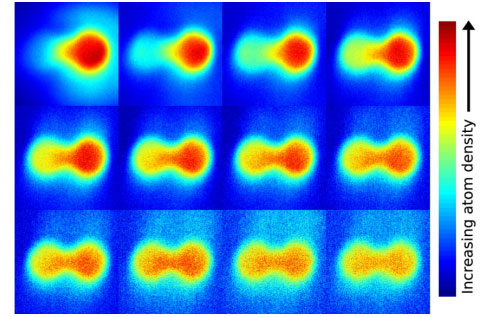| Jan 09, 2013 |
Rudimentary atom capacitor
|
|
(Nanowerk News) First came electronics, the processing of information in terms of the charge of electrons flowing through circuits. Later a new form of tronics, spintronics, was invented to exploit the magnetic properties of electrons. Over the past decade or so still another information modality, atomtronics, has been under development, one employing not electrons but neutral atoms as the vehicle for information. The latest chapter in this development is the demonstration of a rudimentary atomtronic analog of capacitance.
|
|
The new results, undertaken by a group led by Wendell Hill at the Joint Quantum Institute (JQI), are published in the journal Nature Scientific Reports ("Analogs of Basic Electronic Circuit Elements in a Free-Space Atom Chip").
|
 |
| Movement of atoms from one side of atom capacitor to the other.
|
|
For more than a century the movement of electrons in circuits has been described in terms of three handy parameters: resistance, the energy lost by electrons in wires by scattering and heating; capacitance, the storage of energy in the circuit in the form of an excess of electric charge; and inductance, the storage of energy in the form of magnetic fields.
|
|
In the JQI experiment, the atom equivalent of capacitance is the storage of rubidium-87 atoms (chilled in a magneto-optic trap) in one side of a two-compartment enclosure for the atoms. This enclosure is part of what Hill calls a “free-space atom chip.” Unlike conventional microchips sculpted from solid (albeit small) chunks of semiconductors, the free-space chip is sculpted out of laser light, focused into a pattern that holds and manipulates atoms suspended in a vacuum chamber.
|
|
The first figure shows the dumbbell shape enclosure in which atoms can be maintained. At first all the atoms in the sample can be segregated on one side of the enclosure by the optical trap, forming a laser-light barrier. With the removal of the barrier, the “capacitor” is discharged as atoms are free to flow through the channel from one side to the other; this is analogous to discharging a conventional capacitor with a resistor. The rate of this atom flow is proportional to the diameter of the neck between the two enclosures; the narrower the neck the harder it is for atoms to move over. This, Hill says, is a sort of atom equivalent of resistance.
|
|
The second figure shows this atom capacitor “discharging” effect at work. Under some circumstances the atoms might actually slosh back and forth a bit. Hill believes that this oscillation, when properly controlled, might eventually be made to serve as a kind of atom “inductance.”
|
|
“We are still only at the earliest stages – taking only baby steps – of the effort to make true atom circuits,” says Hill. He admits that critical atom components are still lacking, such as the equivalents of batteries or full circuits.
|
|
The next step for the JQI scientists is to form their atoms into a Bose-Einstein condensate, develop further the functioning of atom capacitors, resistors, and inductors. Further along they hope to produce atom equivalents of diodes, transistors, and batteries as well as the equivalent of alternating-current and direct-current circuits. These will be needed, for example, to exploit atom Josephson junctions, superconducting quantum interference devices (SQUIDS), and other neutral-atom based devices under development within JQI.
|

